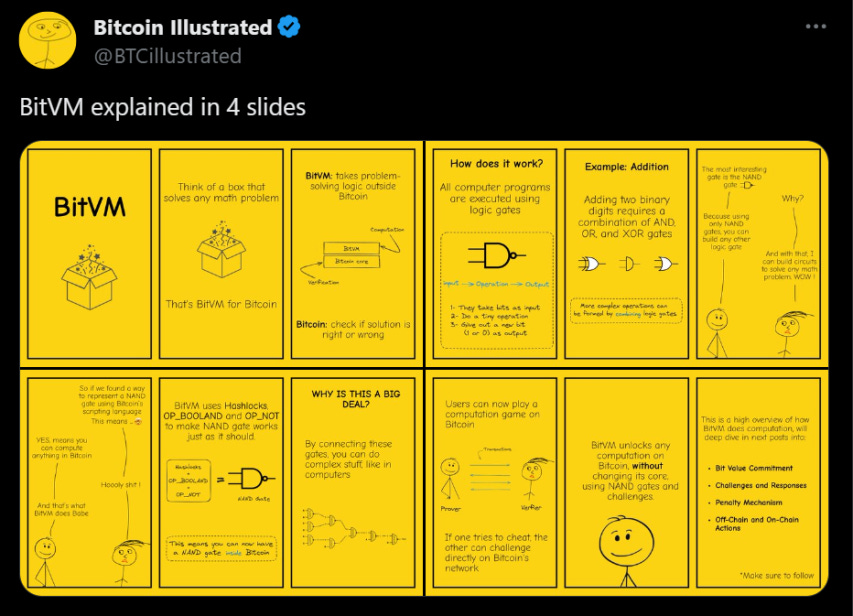
On October 9, 2023, Robin Linus, the mind behind ZeroSync, an organization dedicated to enhancing Bitcoin’s scalability through zero-knowledge proofs, revealed the BitVM whitepaper. This unveiling not only caught the attention of the crypto community but also set the stage for thrilling prospects in Bitcoin application development moving ahead.
Understanding Bitcoin Virtual Machine (BitVM)
BitVM, which abbreviates Bitcoin Virtual Machine, presents a revolutionary solution by introducing Turing-complete smart contracts directly onto the Bitcoin blockchain.
Unlike various other platforms for smart contracts, BitVM doesn’t execute code directly on the Bitcoin blockchain. Instead, it acts as a mechanism to verify the accuracy of off-chain code execution. In simpler terms, it ensures that scripts have been executed correctly outside the Bitcoin network.
An exceptional aspect of BitVM is that it doesn’t necessitate any alterations to Bitcoin’s core consensus rules. It accomplishes this by managing intricate computational tasks off the main Bitcoin blockchain. Only in cases of disputes, when one party contests the result, a few steps of the computation can be brought on-chain for verification. Essentially, this implies that the majority of BitVM activity occurs off the Bitcoin blockchain.
In summary, BitVM enables Bitcoin to execute intricate Turing-complete computations in a verifiable manner, all within the existing Bitcoin framework.
For comparison, one might think of BitVM as somewhat analogous to optimistic rollups on Ethereum. Optimistic rollups assume transaction validity and provide room for disputes. Similarly, BitVM can produce proofs of incorrect execution in cases of fraud or misconduct, but it does so with minimal on-chain overhead. It merely requires the publication of code segments where errors occur.
The distinctive value proposition of BitVM lies in its capability to enable Bitcoin to host smart contracts without requiring a soft or hard fork, preserving the network’s stability and security. While the specific applications are still being explored and developed, potential use cases include trustless bridges, prediction markets, and the introduction of new Op_Codes.
The arrival of BitVM opens up a realm of possibilities within Bitcoin, and as further research unfolds, it’s set to redefine the landscape of decentralized finance.
Examining How BitVM Operates
BitVM makes use of Taproot addresses to reduce its on-chain footprint. It functions within a two-party framework, comprising a Prover and a Verifier. Here’s the process:
- Address Establishment: Both parties deposit Bitcoin into a shared Taproot Address using a 2-of-2 multisignature setup. This ensures that control over the deposited funds requires agreement from both the prover and verifier.
- Challenge and Response: The prover and verifier engage in a sequence of pre-signed transactions. In this sequence, the verifier presents a challenge related to the smart contract, and the prover responds with a solution. This Challenge-Response process continues iteratively.
- Complex Smart Contracts: Before this interaction begins, both the prover and verifier compile the smart contract into a set of if-then statements that cover every possible outcome. This creates a comprehensive map. To save space on the blockchain, this map is ‘Merkelized,’ an efficient technique for compactly representing complex data structures.
- Pre-signed Transactions: In addition to the challenge-and-response setup, both parties jointly pre-sign a sequence of transactions. These pre-signed transactions serve as a safety net in case a dispute arises. They define the conditions under which the deposited funds are transferred.
- Deposit and Access: Once the necessary groundwork is laid, both parties deposit Bitcoin into the shared Taproot address. If the prover successfully responds to all challenges, they gain access to the deposited Bitcoins.
- Failure and Recovery: If the prover fails to meet the challenges or behaves dishonestly, the verifier can claim the Bitcoin placed at stake by the prover. This incentive structure promotes honest behavior.
- Timelocks: Verifiers can also utilize timelocks, setting deadlines for the prover to make decisions. If the prover doesn’t act within the specified time, they risk losing their deposit.
- On-Chain Resolution: Disputes between the prover and verifier lead to the Challenge-Response transactions being posted on the Bitcoin blockchain. This ensures that, in case of disagreements, the blockchain serves as an impartial judge.
- Off-Chain Settlement: If no disputes arise, the transactions can be settled off-chain, making BitVM an efficient and scalable solution for smart contract execution within the Bitcoin network.
Essentially, BitVM’s operation involves a meticulous interplay between two parties, optimizing blockchain resources while upholding the security and enforceability of smart contracts. Here’s a simplified depiction of BitVM through an illustration by Bitcoin Illustrated:

Limitations of BitVM
While BitVM presents an exciting innovation, it’s crucial to acknowledge its constraints.
BitVM, while promising, faces challenges when compared to the Ethereum Virtual Machine (EVM). BitVM demonstrates slower transaction processing, higher operational costs, and increased complexity. In particular, managing off-chain data incurs significant overhead and carries the potential for uncontrollable expansion.
Outlined below are limitations of BitVM highlighted by Bob Bodily, PhD, the founder of bioniq, the initial marketplace for Ordinals on Bitcoin’s Layer 2 Network:
Limitation 1: Restricted to Two-Party System Currently, BitVM contracts are confined to interactions between two parties, limiting their usability. While two individuals can engage in activities resembling smart contracts, this constraint doesn’t seamlessly extend to scenarios involving sidechains or rollups. This significantly restricts BitVM’s versatility.
Progress: Within the BitVM Telegram community, discussions are ongoing regarding numerous ideas for implementing a multi-party system. Although none have materialized practically, it’s essential to note this innovation’s early stage. Over time, a multi-party BitVM smart contract solution might emerge, unlocking a broader range of applications.
Limitation 2: One-Time Use Smart Contracts As observed by Bob, BitVM’s current implementation requires a new Bitcoin transaction for each smart contract interaction between two parties, leading to what he aptly terms “one-time use smart contracts.” While BitVM’s design is intriguing, practical implementation becomes more challenging due to the multitude of interactions between involved parties.
Potential Solution: Addressing this limitation is pivotal. BitVM’s potential advancement in this area may involve integrating a Zero-Knowledge (ZK) verifier into its framework. If successful, it could introduce genuine Layer 2 solutions on Bitcoin, where Layer 2 proofs can be verified within BitVM’s ZK verifier. This could transform BitVM into not just a Bitcoin Layer 2 but also reduce trust assumptions when bridging to a Layer 2 and transacting within it. BitVM might be the key to unlocking Layer 2 capabilities on Bitcoin without necessitating a network upgrade.
For a detailed exploration of these limitations and potential solutions, refer to Bob’s comprehensive thread.
Closing Remarks
In summary, BitVM represents a thrilling innovation that introduces smart contracts into the Bitcoin ecosystem without resource-intensive hard forks since most computational tasks occur off-chain. While its current focus revolves around two-party interactions, the potential for future expansions is substantial, akin to the Lightning Network and integration with off-chain protocols. Notably, BitVM illustrates that Bitcoin can achieve Turing completeness, offering a framework to verify any program’s execution, even within a two-party context.
BitVM stands as one of the most thrilling technical accomplishments within the Bitcoin sphere recently. Its presence in the blockchain arena seems enduring, and despite existing limitations, the prevailing sentiment suggests these challenges are surmountable. Extensive low-level development lies ahead before fully leveraging BitVM’s potential, but a community of talented developers is actively propelling its evolution.
The BitVM narrative is far from over. As it matures and evolves further, it could reshape smart contracts and computation within the Bitcoin network. With innovative minds guiding its path, BitVM’s journey is captivating and offers the promise of unlocking remarkable possibilities for Bitcoin’s future and decentralized finance.
